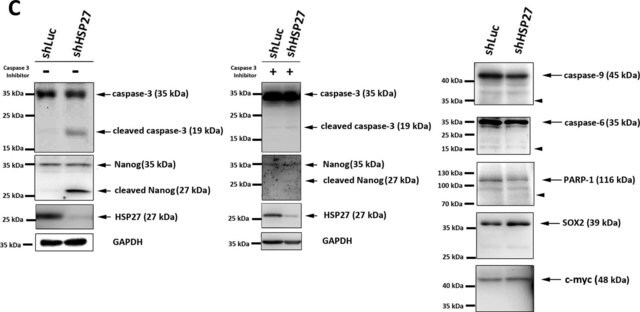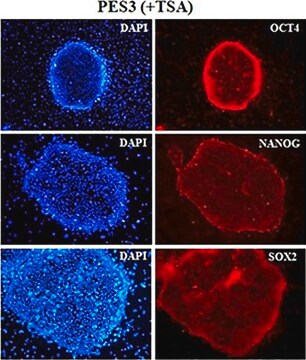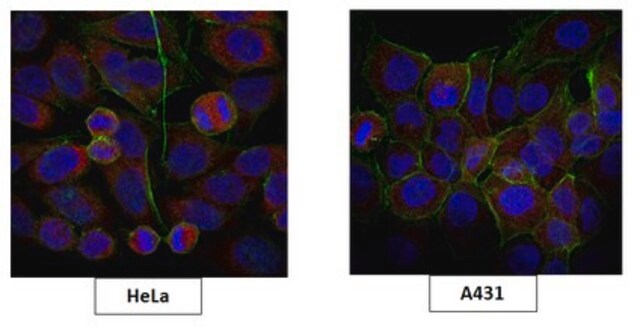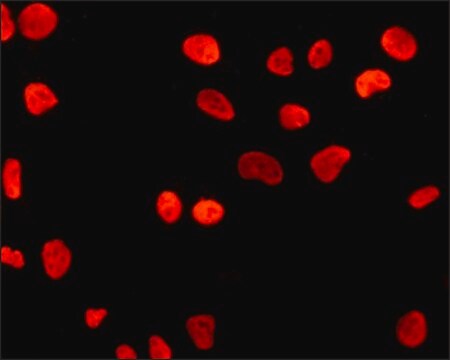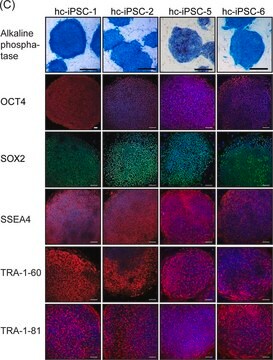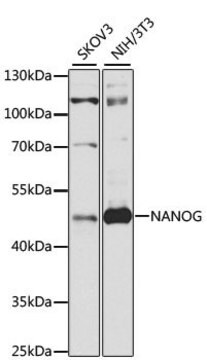推薦產品
生物源
mouse
品質等級
抗體表格
purified antibody
抗體產品種類
primary antibodies
無性繁殖
7F7.1, monoclonal
物種活性
human
技術
immunocytochemistry: suitable
western blot: suitable
同型
IgG2aκ
NCBI登錄號
UniProt登錄號
運輸包裝
wet ice
目標翻譯後修改
unmodified
基因資訊
human ... NANOG(79923)
一般說明
NANOG (Homeobox protein NANOG) is a member of the Nanog homeobox family of DNA-binding proteins. It is expressed in embryonic stem cells and confers pluripotency on these cells. Once embryonic stem cells become differentiated, NANOG expression is suppressed. NANOG is involved in the Hedgehog/Gli1 signaling pathway which has been implicated in the development and growth of various types of tumors.
免疫原
GST-tagged recombinant protein corresponding to human NANOG.
應用
Anti-NANOG Antibody, clone 7F7.1 is an antibody against NANOG for use in Western Blotting, ICC.
Immunocytochemistry Analysis: A 1:500 dilution from a representative lot detected NANOG in H9 human embryonic stem cells.
Research Category
Stem Cell Research
Stem Cell Research
Research Sub Category
Transcription Factors
Transcription Factors
品質
Evaluated by Western Blot in H9 human embryonic stem cell lysate.
Western Blot Analysis: 0.5 µg/mL of this antibody detected NANOG on 10 µg of H9 human embryonic stem cell lysate.
Western Blot Analysis: 0.5 µg/mL of this antibody detected NANOG on 10 µg of H9 human embryonic stem cell lysate.
標靶描述
~39 kDa observed
外觀
Protein G Purified
Format: Purified
Purified mouse monoclonal IgG2aκ in buffer containing 0.1 M Tris-Glycine (pH 7.4), 150 mM NaCl with 0.05% sodium azide.
儲存和穩定性
Stable for 1 year at 2-8°C from date of receipt.
分析報告
Control
H9 human embryonic stem cell lysate
H9 human embryonic stem cell lysate
其他說明
Concentration: Please refer to the Certificate of Analysis for the lot-specific concentration.
免責聲明
Unless otherwise stated in our catalog or other company documentation accompanying the product(s), our products are intended for research use only and are not to be used for any other purpose, which includes but is not limited to, unauthorized commercial uses, in vitro diagnostic uses, ex vivo or in vivo therapeutic uses or any type of consumption or application to humans or animals.
未找到適合的產品?
試用我們的產品選擇工具.
儲存類別代碼
12 - Non Combustible Liquids
水污染物質分類(WGK)
WGK 1
閃點(°F)
Not applicable
閃點(°C)
Not applicable
分析證明 (COA)
輸入產品批次/批號來搜索 分析證明 (COA)。在產品’s標籤上找到批次和批號,寫有 ‘Lot’或‘Batch’.。
Ambrin Fatima et al.
Stem cell research, 44, 101739-101739 (2020-03-04)
Incontinentia pigmenti (IP) is an X-linked dominant neuroectodermal dysplasia caused by loss-of-function mutations in the IKBKG gene. Using CRISPR/Cas9 technology, we generated an IKBKG knock-out iPSC line (KICRi002-A-1) on a 46,XY background. The iPSC line showed a normal karyotype, expressed
Jens Schuster et al.
Stem cell research, 57, 102577-102577 (2021-10-24)
Heterozygous variants in POLR2A, encoding the largest subunit of RNA polymerase II, cause severe neurodevelopmental and multisystem abnormalities in humans. Using CRISPR/Cas9 we generated the human iPSC line KICRi002A-5 with a heterozygous truncating 4 bp insertion in exon 5 of the
Jens Schuster et al.
Stem cell research, 39, 101523-101523 (2019-08-11)
Dravet syndrome (DS) is a childhood epilepsy syndrome caused by heterozygous mutations in the SCN1A gene encoding voltage-gated sodium channel Nav1.1. We generated iPSCs from fibroblasts of three DS patients carrying distinct SCN1A mutations (c.5502-5509dupGCTTGAAC, c.2965G>C and c.651C>G). The iPSC
Yifan Zhou et al.
Molecular autism, 7, 42-42 (2016-10-08)
Fragile X syndrome (FXS), a common cause of intellectual disability and autism, results from the expansion of a CGG-repeat tract in the 5' untranslated region of the FMR1 gene to >200 repeats. Such expanded alleles, known as full mutation (FM)
Jens Schuster et al.
Stem cell research, 38, 101474-101474 (2019-06-10)
Von Hippel-Lindau (VHL) syndrome is a familial cancer syndrome caused by mutations in the tumor suppressor gene VHL. We generated human iPSC lines from primary dermal fibroblasts of three VHL syndrome patients carrying distinct VHL germ line mutations (c.194C>G, c.194C>T
文章
Skip weekend feedings. Defined serum-free and feeder-free expansion media for human pluripotent stem cells (ES and iPS cells). See publications and protocols.
The Simplicon™ RNA Reprogramming Technology is a next generation reprogramming system that uses a single synthetic, polycistronic self-replicating RNA strand engineered to mimic cellular RNA to generate human iPS cells.
我們的科學家團隊在所有研究領域都有豐富的經驗,包括生命科學、材料科學、化學合成、色譜、分析等.
聯絡技術服務![Anti-OCT-4 [POU5F1] Antibody, clone 7F9.2 clone 7F9.2, from mouse](/deepweb/assets/sigmaaldrich/product/images/307/874/7354f72d-80ee-40a5-b7fa-0590fe6784cc/640/7354f72d-80ee-40a5-b7fa-0590fe6784cc.jpg)
